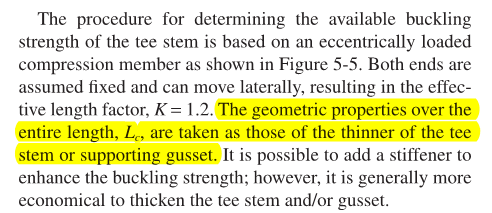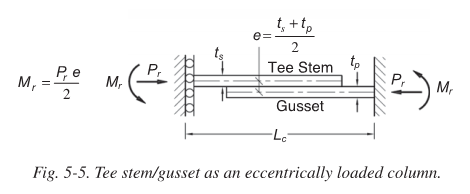Looking for some insight into a matter. Looking at 'Design Guide 24-Hollow Structural Section Connections' (which is readily available online), section 5.2 talks about the procedure for checking buckling strength of a tee stem. Eq. 5-1 and 5-2 show the generic formula for members subject to axial and bending forces. Eq. 5-3 and 5-4 are manipulated to provide the maximum axial force on the basis that the moment, M = P*e/2. This suggests that the moments at each end are equal (as shown in Figure 5-5) and that each plate is required to resist 1/2 of the moment induced due to the eccentricity. In the event that the lapping plate thicknesses are not equal to one another,could Eq. 5-1 and 5-2 be manipulated to reflect the rigidity of each plate?... meaning the thicker plate resists a greater percentage of the moment induced by the eccentricity. Aside from the need to derive the maximum axial force equation from Eq. 5-1 and 5-2 and checking it against the respective plate, it seems this would a more efficient approach to better reflect how the plates resist bending (when the thicknesses vary).
As an generic example, if a 1" gusset plate joined with a 1/4" plate, could the 1" gusset resists P*(3/4*e) and the 1/4" plate resist P*(1/4*e) (the fractions listed are made up, not to reflect the rigidity each plate would have relative to the other). The design guide (and any other literature I've found) provides examples which assume the lapping plates are equal in thickness (not very representative of real life connections)
Many thanks for any input on the subject.
As an generic example, if a 1" gusset plate joined with a 1/4" plate, could the 1" gusset resists P*(3/4*e) and the 1/4" plate resist P*(1/4*e) (the fractions listed are made up, not to reflect the rigidity each plate would have relative to the other). The design guide (and any other literature I've found) provides examples which assume the lapping plates are equal in thickness (not very representative of real life connections)
Many thanks for any input on the subject.


